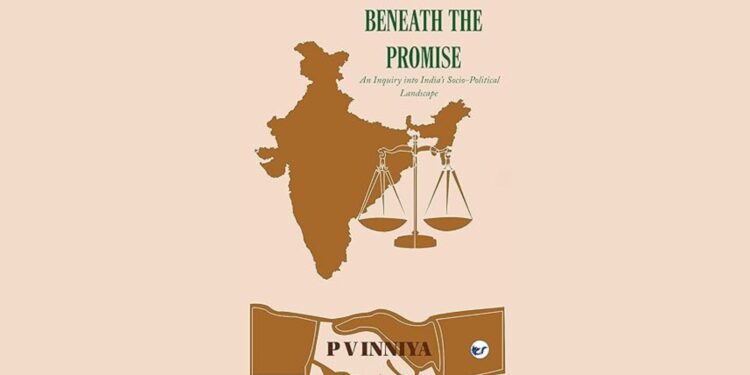
Beneath The Promise: India is often celebrated as a land of equality, justice, and fraternity—a nation whose Constitution promises a fair and inclusive society. Yet, for all its ideals, the social fabric of the country tells a different story. Caste, a centuries-old hierarchy, continues to influence lives, politics, and interactions at every level. PV Inniya’s Beneath The Promise: An Enquiry Into India’s Social Political Landscape boldly addresses this paradox, offering a profound and eye-opening exploration of how ancient social structures persist in contemporary India.
Tracing the Roots of Inequality
Inniya takes readers on a journey through history, illuminating the origins and evolution of caste. From its early social and occupational foundations to its entrenchment during colonial rule, the book provides a comprehensive look at how caste became a defining feature of Indian society. Inniya deftly shows how historical policies and societal practices cemented inequalities, creating structural barriers that continue to challenge the ideals of justice and equality. This historical perspective not only educates readers but also highlights the deep-seated roots of modern-day disparities.
The Constitution and the Struggle for Equality
A significant portion of the book Beneath The Promise examines the tension between India’s constitutional ideals and social reality. Visionaries like Dr. B.R. Ambedkar fought tirelessly to embed principles of justice and equality into the nation’s legal framework, yet societal attitudes often undermine these promises. Inniya’s analysis of the law versus lived experience is both insightful and sobering. By combining legal study with real-life examples, the author makes it clear that legislation alone is not enough; societal transformation requires sustained effort and collective awareness.
Caste and Contemporary Politics
Beneath The Promise also scrutinizes the role of caste in India’s political landscape. Inniya illustrates how caste identities are still leveraged in electoral strategies, often shaping voting patterns and party agendas. The book provides a nuanced look at how political mobilization around caste perpetuates divisions, revealing the complex interplay between social structures and democratic governance. It challenges readers to consider how deeply ingrained social hierarchies influence even the modern institutions that are meant to uphold equality.
One of the book’s most inspiring aspects is its focus on leaders who have challenged caste-based discrimination. From Ambedkar’s pioneering advocacy to Thiruvalluvar’s philosophical insights on morality and equality, Inniya celebrates the individuals who dared to confront societal norms. Their stories serve as both a historical record and a source of motivation, reminding readers that persistent effort and vision can spark social transformation.
Engaging, Accessible, and Thought-Provoking
Despite its heavy subject matter, Beneath The Promise is highly readable. Inniya blends research, historical facts, and political analysis with accessible prose that engages both scholars and general readers. The use of examples, anecdotes, and case studies makes complex social and political dynamics easy to grasp, ensuring that the book is informative without being overwhelming.
Above all, Beneath The Promise serves as a call to action. It challenges readers to not only reflect on the persistence of caste but also consider their role in promoting change. Inniya provides practical insights and suggestions for policymakers, educators, and socially conscious citizens, emphasizing that progress requires both awareness and deliberate action.
Conclusion
Beneath The Promise is more than a study of caste; it is a mirror reflecting India’s social and political contradictions. PV Inniya’s work is thorough, deeply researched, and enlightening, making it a must-read for anyone seeking to understand the complexities of Indian society. The book succeeds in combining historical perspective, legal analysis, and contemporary commentary into a compelling narrative that informs, challenges, and inspires.
For students, activists, policymakers, and curious citizens, Beneath The Promise is not just an academic exercise—it is a thoughtful exploration of social justice and a guide for envisioning a more equitable India. Inniya’s work encourages readers to confront uncomfortable truths and embrace the collective responsibility needed to bridge the gap between India’s constitutional promises and its social realities.
















